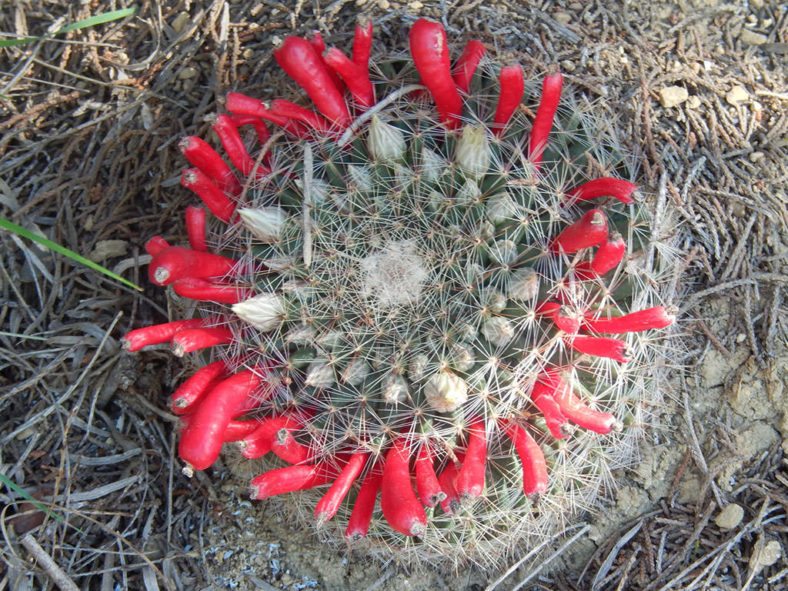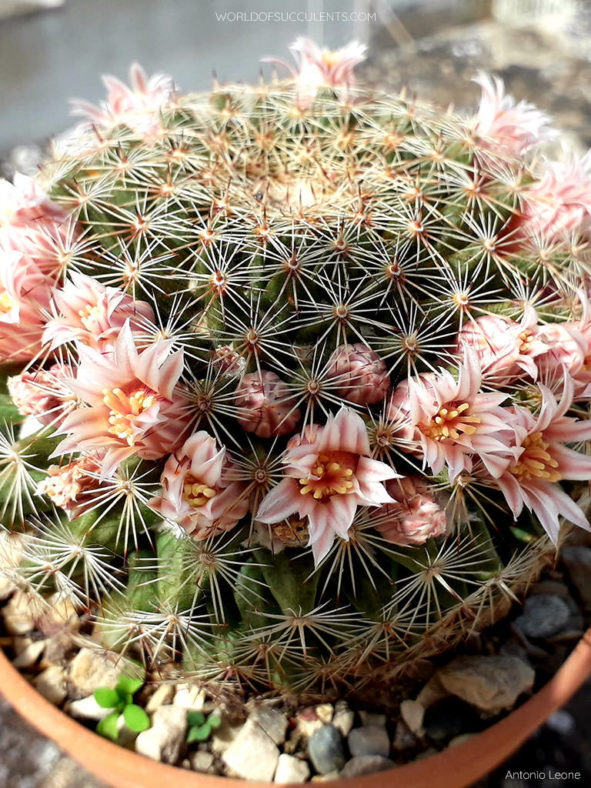Scientific Name
Mammillaria heyderi Muehlenpf.
Common Name(s)
Ball Cactus, Coral Cactus, Cream Cactus, Cream Pincushion, Flat Cream Pincushion, Heyder's Nipple Cactus, Heyder's Pincushion, Heyder's Pincushion Cactus, Little Nipple Cactus, Nipple Cactus, Pancake Pincushion, Small-spined Cream Pincushion
Synonym(s)
Cactus heyderi, Mammillaria heyderi subsp. heyderi, Neomammillaria heyderi
Scientific Classification
Family: Cactaceae
Subfamily: Cactoideae
Tribe: Cacteae
Subtribe: Cactinae
Genus: Mammillaria
Etymology
The specific epithet "heyderi (HEY-der-eye)" honors Edward Heyder (1808-1884), a German cactus grower.
Origin
This species is native to Mexico (Coahuila, Nuevo León, Tamaulipas) and the United States (Arizona, New Mexico, Oklahoma, and Texas). It grows in dry, rocky, sandy soils of desert scrub and limestone hills at elevations from 4,000 to 7,000 feet (1229 to 2130 m).
Description
Mammillaria heyderi is a small cactus with a solitary, depressed globose stem with conical or pyramidal tubercles tipped with clusters of stout spines. In its native habitat, it grows underground, and the stem is barely above the soil. The stem can reach up to 3.6 inches (9 cm) in height and 6 inches (15 cm) in diameter. The tubercles can grow up to 0.6 inches (1.5 cm) long and 0.3 inches (0.7 cm) in diameter at the base. In the axils, between the tubercles, there is short white wool. Each areole bears 10 to 22 needle-like radial spines measuring up to 0.5 inches (1.2 cm) long and one shorter central spine measuring up to 0.3 inches (0.8 cm) long. They are all usually brownish and darker at the tip.
The flowers are white, greenish, or cream to pale pink, with tan, pink, greenish, or brownish midstripes. They can reach up to 1.5 inches (3.8 cm) in length and 1.2 inches (3 cm) in diameter and appear in spring, forming a circle around the stem just below the apex. The fruits are juicy, brilliant red, and contain reddish brown, sometimes yellowish seeds. They are club-shaped and can grow up to 1.4 inches (3.5 cm) long and 0.3 inches (0.8 cm) in diameter.

How to Grow and Care for Mammillaria heyderi
Light: Plant this cactus in an area of your garden that receives 4 hours of direct sunlight daily. If you are growing M. heyderi indoors, place it near the brightest window in your home or office to ensure your cactus gets enough light. Place the pot on the balcony or in the garden for extra light from spring to fall if possible.
Soil: M. heyderi requires a soil mix that provides root aeration and good drainage, whether grown outdoors or indoors. Use a commercial cactus potting mix, or create your own.
Temperature: This cactus is heat tolerant but not a cold-hardy plant. M. heyderi can withstand temperatures as low as 25 °F (-3.9 °C). USDA Plant Hardiness Zones 9b to 11b, 25 to 50 °F (-3.9 to 10 °C).
Watering: From spring to fall, water deeply and wait for the soil to dry before watering again. Never let the pot sit in water. Suspend watering in the winter.
Fertilizing: M. heyderi can benefit from fertilizing during the growing season. Apply a water-soluble fertilizer for cacti and other succulents. Suspend feeding during the winter when the plant goes dormant.
Repotting: Repot every two or three years into a slightly larger pot. The best time to repot your M. heyderi is late winter or early spring, but the repotting process can be done almost any time.
Propagation: Since a plant with a solitary growth habit, M. heyderi can be propagated only from seeds. Sow the seeds in late spring or summer.
Learn more at How to Grow and Care for Mammillaria.
Toxicity of Mammillaria heyderi
M. heyderi is considered non-toxic to both humans and pets.
Links
- Back to genus Mammillaria
- Succupedia: Browse succulents by Scientific Name, Common Name, Genus, Family, USDA Hardiness Zone, Origin, or cacti by Genus
Photo Gallery
Click on a photo to see a larger version.


